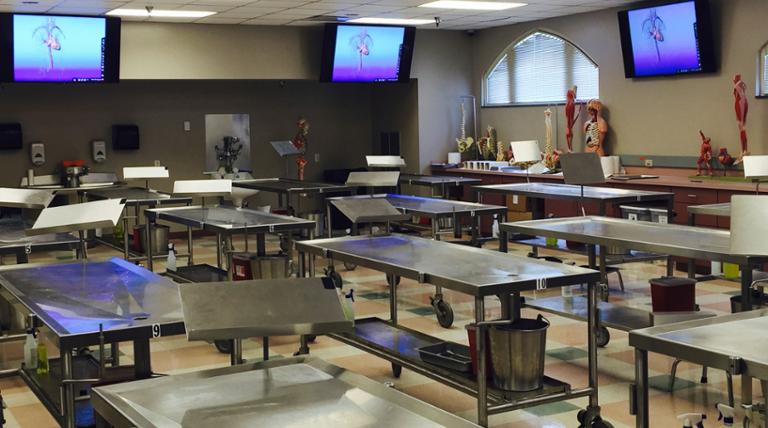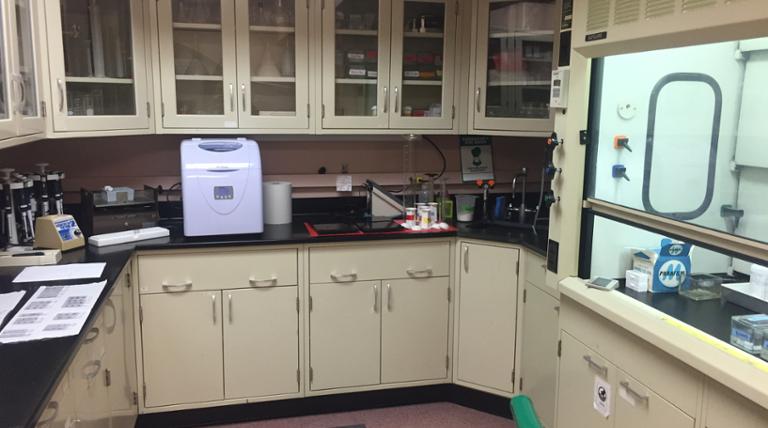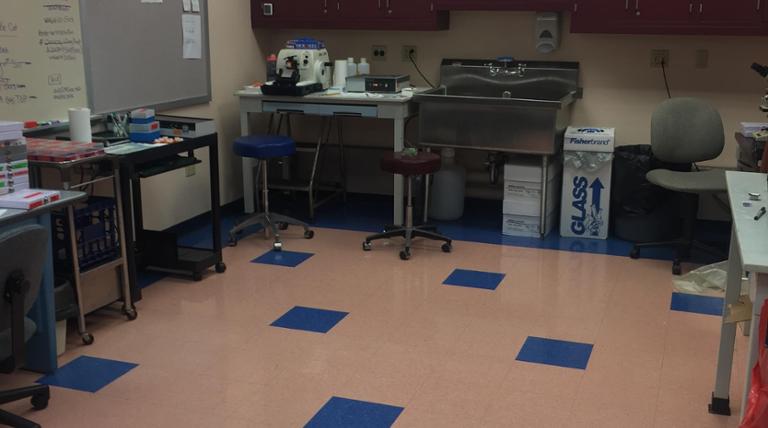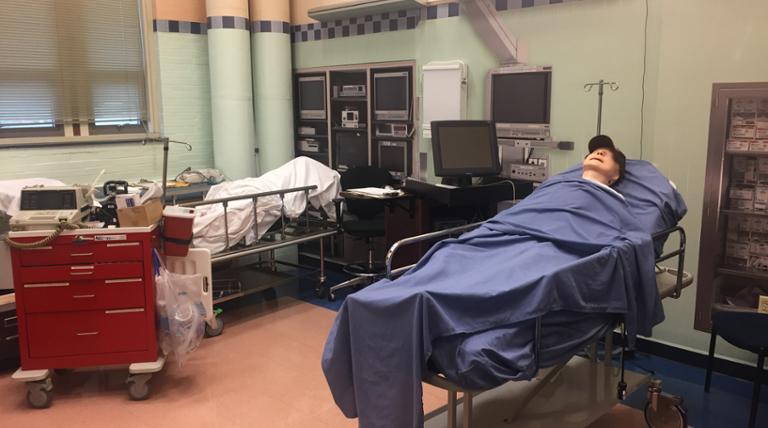The John G. Rangos Sr. School of Health Sciences occupies space in the School of Health Sciences Building, as well as Libermann Hall and Fisher Hall.The School of Health Sciences building provides faculty and staff offices and teaching and research laboratories. The fourth floor includes the Anatomy Research and Teaching Laboratory, and Multimedia Room.
Fisher Hall
Fisher Hall houses the departmental offices and primary clinical laboratories for the Departments of Health Management Systems and Speech-Language Pathology.
This includes a Speech Clinic with special programs in: adult aphasia, pediatric language disorders, pediatric multi-handicapped populations, pediatric and adult stuttering, aural rehabilitation, central auditory processing, phonological disorders, voice disorders, cognitive communicative disorders, and language learning disabilities. Students and faculty work together as part of the educational process to provide clinical services to clients with these speech abnormalities.
Rangos Laboratories located in Fisher Hall
- Athletic Training - exercise physiology laboratory
- Physical Therapy - teaching/research laboratories; infant development lab
- Occupational Therapy - therapeutics laboratory and psychophysics laboratory
- Health Management Systems - 2 computer laboratories
- Rehabilitation Science - Kristen McMaster Human Movement Laboratory
- Speech-Language Pathology - language science laboratory, speech science laboratory, and teaching laboratory
Labs
Teaching and research laboratories
Human Anatomy Dissection Laboratory - 402 Health Sciences Building
The Human Anatomy Dissection Laboratory supports student learning by providing cadaver
dissection for students preparing for careers in the Health Sciences. Students are
guided through dissection of the major regions and systems of the body in an effort
to gain intimate knowledge of human anatomy that may be applied to their respective
discipline of study. Thanks to the generosity of human donors that commit their bodies
to science, students perform their own dissections at one of 16 independent dissection
stations. The lab is equipped with state of the art technology that features 8 60"
high definition monitors that can project computer generated, detailed images or provide
live, streaming video from a mobile video device that captures the details of the
professor's instructions. There is a separate, adjoining room to the anatomy lab that
has been converted into a virtual anatomy lab. The lab contains 5 computer stations
that is equipped with z-space technology. The z-space lab utilizes advanced 3D technology
to provide students with interactive experiences with highly detailed anatomical models.
This new lab offers a unique opportunity for students to interact with technology
in an effort to enhance their knowledge of human anatomy. The lab facilities and technology
allow the students to immerse themselves in the study of human anatomy with the aid
of technology and human donations.
Basic Science Laboratory - 339 Health Sciences Building
The basic science laboratory is equipped to support multiple forms of bench investigation.
A common space houses refrigerated and non-refrigerated microcentrifuges, macro and
micro-scales, a speed-vac, pH meter and water purification system. There are dedicated
spaces equipped for high-pressure liquid chromatography and cell culture.
Histology Laboratory - 238 Health Sciences Building
This 322sq.ft laboratory supports investigation for basic science research. The lab
contains a desk with computer and chair & several pieces of equipment including: a
cryostat, 2 microtomes, a fluorescent microscope, an isotemp vacuum oven, a paraffin
oven, refrigerator and computer.
203E Fisher Hall
The Infant Development Lab seeks to investigate how infants learn using their bodies and minds together. We focus on carefully observing and collecting data on both infants with typical development and infants with delayed or atypical development as new skills emerge. We also explore advances in intervention to accelerate and encourage the acquisition of early movement and thinking skills, and thus determine which interventions are most effective. Our focus is on activities and interventions that occur in the community with families.
We are studying the effect of sleep on infant problem solving for infants (age 6 to 8 months) who are learning to sit.
The lab consists of a comfortable, family friendly room and is equipped with a Positive Science eyetracking system and multiple GoPro cameras for monitoring movement and vision in real-life situations. The small, portable equipment lets our research take place in the home or day care setting of the infant, allowing capture and subsequent analysis of natural behaviors.
Email Reggie Harbourne, PT, PhD, PCS, Lab Director, 104 Rangos School of Health Sciences
Watch Dr. Regina Harbourne's interview with TEIS, a local early intervention therapy group.
The Kristen McMaster Human Movement Laboratory - 232 Health Sciences Building
The Kristen L. McMaster’s Biomechanics Laboratory, located on the second floor in the Rangos School of Health Sciences, is equipped with contemporary biomechanics research equipment including: an electromagnetic motion analysis system, telemetry EMG, force plate, electrogoniometer, foot switches, digital inclinometers and a custom built perturbation device.
Exercise Physiology Laboratory - 437 Fisher Hall
This laboratory supports investigation of human physical performance. The lab houses 2 Monark Bicycle Ergometers, 1 Upper Body Ergometer, Biodex, 2 Portable ECG units, 2 Portable Spirometers, 2 Pulse Oximeters, 5 Lange Calipers, 5 Skyndex Calipers, Jumpboxes, 2 Treadmills, and a Metabolic Cart. Additionally, five Polar Monitors with computer interface, are available for automatic assessments of heart rate. The computer interface allows heart rate data to be stored, downloaded, and processed through a data management program.
Health Management Systems Laboratories
These are computer laboratories for Internet development tools, database applications, systems analysis and design, and networking applications. In one laboratory computers are configured with Microsoft Office Suite, Go Live, Image Styler, Photoshop, Illustrator, Visual Studio, Front Page, Case Tool: Inspiration, Java, JavaScript and Netscape. The second laboratory houses 15 computers, two servers, and one printer. All may be reconfigured in various LAN and WAN topologies. Unix and NT are the dominant platforms.
Simulation Laboratory - 239 Health Sciences Building
This 300 sq.ft lab houses two adult (one male; one female) and one infant high fidelity
simulators, a metabolic cart with defibrillator and computer.
SLP Language Science Laboratory - 413 Fisher Hall
This research laboratory is used by faculty and students pursing work related to normal and disordered language processing in children and adults. The laboratory is equipped with a Noldus digital video analysis system which allows for the coding and analysis of communication behaviors such as gestures, speech, vocalizations, use of contextual information, and partner reactions.
SLP Clinical Laboratory- 406 Fisher Hall
The Duquesne University Speech-Language-Hearing Clinic represents an opportunity for research on human communication and its disorders. The clinic consists of eight individual and group treatment rooms each connected to an associated observation area via a one-way observation window. Each treatment room is equipped with both a sound system and a private intercom system. Seven of the eight rooms have wall-mounted video cameras allowing for recording and off-line analysis of clinical and/or research data. Additionally, the clinic houses a soundproof booth and equipment for the testing of hearing.
Speech Science Laboratory
The laboratory is equipped with hardware and software for the digital and analog acquisition and analysis of speech (i.e., Computerized Speech Laboratory and Nasometer, both from the Kay Elemetrics corporation). The equipment allows investigation of the mechanisms of speech production.
Department of Speech Language Pathology Teaching Laboratory - 400 Fisher Hall
The teaching laboratory is used for classroom instruction and demonstration to maximize student learning. The laboratory is equipped with anatomical models related to speech, language and hearing. The laboratory is also designed to allow instructors to demonstrate and teach the use and interpretation of the range of digital and analog equipment available in other laboratory and clinical areas of the department. The laboratory is equipped with Internet access and multimedia projection capability allowing for excellent viewing of demonstrations used for teaching purposes.

